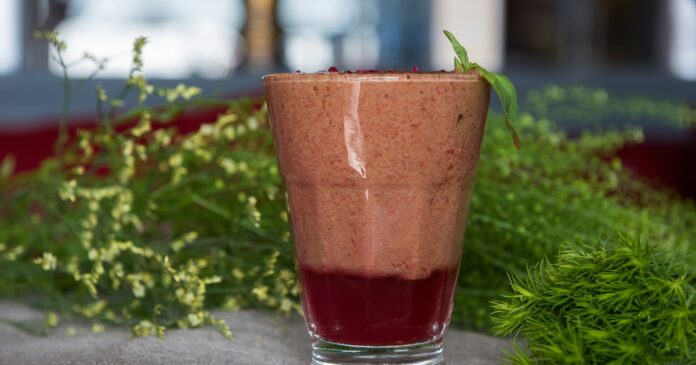Smoothies may be touted as nutritious, but drinking them doesn’t necessarily make people healthier. They can actually contribute to weight gain and negatively affect one’s health if people aren’t careful.
Smoothies that contain mostly fruit and have added sugar – especially smoothies bought at stores – can contribute to higher calorie counts. They can be less-filling than other foods, leading people to snack later. And consuming smoothies with a meal, rather than instead of a meal, adds unneeded calories, health experts say.
Smoothies “have evolved into having a health halo even if you put a lot of fruit juice and syrups into them,” registered dietician and nutritionist, Bonnie Taub-Dix, told Prevention. “It can make you feel invigorated for a little bit because of the sugar high, but then you’re left feeling hungry shortly afterward.”
Adding ingredients such as honey, agave nectar and maple syrup are healthier than refined sugar and can offset the taste of leafy green vegetables in smoothies. But these sugar substitutes are still high in calories and may contribute to weight gain if they are overused, registered dietician nutritionist Mary Sabat told Eat This, Not That!
Also, though using protein powders in smoothies can be nutritious, it depends on the product. Some protein powders contain added sugars and carbohydrates, so people need to read the label, dietician Jordan Spivak told Johns Hopkins Medicine.
A balance of healthy ingredients is the key to healthy smoothies, dietitian Lorraine Fye said in a Mayo Clinic article.
“You want good carbohydrates, good proteins and good healthy fats,” Fye said. If you are substituting a smoothie for a meal, make sure the smoothie “really is replacing the meal. Not too few calories, but not too many calories.”
To lose weight, keep snack smoothies under 150 calories and meal-replacement smoothies at 350 calories or less, Stanford Health clinical dietician, Leah Groppo, told Prevention. And make sure the smoothie cup isn’t too big. People should aim for 8 ounces and refrigerate or freeze any overflow for another day, she said.
And if the smoothie is thick enough, eat it with a spoon rather than sipping it through a straw. Chewing helps the body release hormones that make people feel fuller, Groppo said.
The YouTube video below from the Mayo Clinic offers tips for making healthy smoothies.
How to make healthy, filling smoothies
• Use a low-calorie, liquid base. Water carries nutrients to cells, rids the body of wastes and maintains body temperature, so it is a smart choice as a smoothie starter. Other low-calorie, healthy smoothie liquids include oat milk (which is rich in fiber and lactose free) and coconut milk (which is dairy, lactose free and nutrient rich).
• Use low-sugar fruit, such as watermelon, raspberries and blueberries. Prevention lists 10 low-calorie fruits, from highest to lowest sugar content. Also, using frozen fruit makes smoothies thicker and more filling – and chills them, which some people prefer. Adding more vegetables than fruits and no more than two fruits per smoothie increases nutrition and cuts calories.
• Add protein. Protein builds lean muscle, repairs muscle, helps maintain healthy body weight and reduces hunger. Greek yogurt (which has twice the protein of regular yogurt), chia seeds (which have robust amounts of fiber and omega-3 fatty acids) and protein powders (especially plant-based ones that come from pea, rice or hemp) are great choices for adding protein to smoothies.
• Add fiber. Fiber helps with gut health and improves digestion. It also creates a sense of fullness, which helps stave off snacking. Pulp contains the fiber in the fruit, so blend whole fruits into smoothies. Nuts, seeds and whole vegetables are rich in fiber.
• Use green ingredients. Green vegetables contain essential vitamins, minerals and fiber – and many of people don’t eat enough of them – so adding them to smoothies is a way to get them in. Kale, spinach, collard greens, chard and wheatgrass are healthy options.
Berry Green Smoothie recipe
Try this recipe for a healthy smoothie from Johns Hopkins Medicine.
Blend together:
• 1 cup of frozen mixed berries
• A generous handful of spinach (frozen or fresh)
• 1 scoop of vanilla protein powder
• 1/2 cup of vanilla Greek yogurt (or vanilla coconut yogurt as a dairy alternative)
• 1 cup of base liquid (water or milk/milk alternatives such as almond or cashew milk)
• 1 tablespoon of ground flaxseed
• A few ice cubes
Nutrition facts per serving: 303 calories, 35.8 grams of carbs, 30.4 grams of protein, 6.8 grams of fat. Nutrition facts will vary depending on brands used, amounts and types of ingredients.



